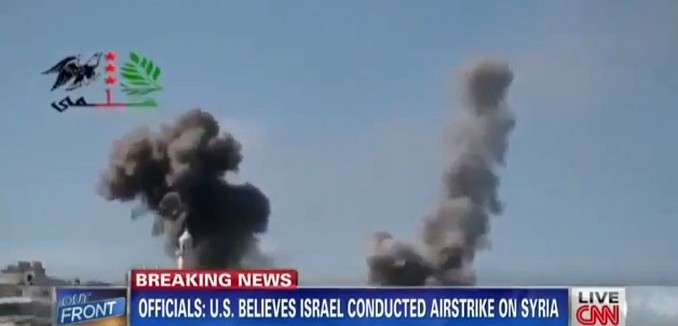By striking military targets inside Syria three times since January – twice this past weekend alone – Israel is engaging in what Former Secretary of State John Foster Dulles would have described as a “brinksmanship” strategy.
It is not in Israel’s national interest to intervene in the bloody Syrian civil war – a sad, violent, and regionally destabilizing conflict with no end in sight that has so far lasted for nearly two-and-half-years, killed at least 70,000 people, wounded countless more, and produced nearly two million refugees. Nor is Israel’s intention to do so.
Though the Israeli government has mostly maintained official silence – neither confirming nor denying – there are sufficient hints to conclude that all the three aerial attacks, on sensitive military facilitates and on Hezbollah and Iranian assets in Syria, were carried out by the Israeli Air Force.
The first, in January, destroyed a convoy loaded with Russian made SA-17 anti-aircraft missiles destined for Hezbollah in Lebanon.
The targets struck over this weekend included depots of medium range surface-to-surface missiles also destined for the Iranian-backed Shiite terror group. Another target was Jamraya, Syria’s most secretive military R&D center. It is situated in northwest Damascus, the Syrian capital. Israeli intelligence sources tell The Tower that the facility housed sensitive Syrian research on chemical weapons as well as long-range guided missiles.
All three attacks have some traits in common. They illustrate a pattern.
Operationally the military operations demonstrated excellent precise intelligence. It must have been gathered over months and even years of painstakingly work from agents on the ground, communication intercepts, aerial reconnaissance, and satellite imagery.
Politically and diplomatically they highlight the determination of the Israeli government not to repeat past mistakes.
Since 1996, consecutive Israeli governments neglected and ignored the systematic, ongoing transfer of Iranian-made rockets and missiles to Hezbollah via Syria.
As a result of this choice – and even after U.N. Security Council Resolution 1701 demanded the disarmament of Hezbollah and an end to the smuggling of weapons into Lebanon – Assad’s terrorist allies amassed more than 40,000 rockets and missiles of all types and ranges. Their arsenal included long range missiles capable of hitting almost every target in Israel – including military bases, airfields, power stations, and the nuclear reactor in Dimona.
The previous government, still in power during the January air strike, and this government, decided that enough was enough. Both governments have been helmed by Prime Minister Benyamin Netanyahu.
Israel is determined to stop shipments of weaponry systems it calls “game changing.” They include Russian made anti-aircraft missiles, Russian made surface-sea Yakhont missiles, and the Iranian made Fateh-110 (Victory) and M-600 surface missiles. Those can carry both conventional and chemical warheads.
The Israeli strategy is based on a calculated risk. It assumes that the Assad regime is too weak to respond, and that neither Iran nor Hezbollah have the desire to escalate the situation.
There is of course the risk that repeatedly hitting a weakened President Bashar al-Assad will goad him to retaliate for the sake of his personal honor and national pride. His options however are narrow. Assad can order a launch missile attacks against Israeli military targets. He can “green light” Palestinian proxies to conduct terror operations against Israeli rural communities in the Golan Heights. He can pressure Hezbollah to carry out on his behalf “punitive” measures against northern Israel. But Assad and his backers in Tehran must also be wary, and they know that in all these scenarios Israel will respond forcefully.
Israel must guess Assad’s redlines, and must gauge whether further Israeli weapons interdictions will trigger an open response from Damascus. Israel has been adament – and has conveyed to Assad – that it is not acting to destabilize the Syrian regime. But Israeli Defense Minister Moshe Ya’alon has hinted that further actions remain possible.
While it is unclear if the Iran-Syria-Hezbollah axis understands that years of impunity regarding arms shipments have come to an end, one conclusion is clear albeit contradictory.
Many believe that Israel’s airstrikes, and its determined actions to enforce its red line, were been coordinated with and approved by the Obama administration. The White House, under this theory, sought room to dispel criticism, at home and abroad, that the United States has not been assertive enough in working to topple the brutal Assad regime or in responding to the reported use of chemical weapons. If so, the gambit could be dangerous, because Israel’s successful operations undermine administration arguments regarding the sophistication of Syrian air defenses – and the danger that would be posed to the U.S. or NATO in penetrating them.
If the Israel Air Force has done it, surely the US Air Force or NATO are capable of enforcing a non-fly zone that would at least reduce the bloodshed.
Yossi Melman is an senior Israeli national security analyst and a Contributing Editor at TheTower.org. This is his debut piece at TheTower.org
[Photo: YouTube]




